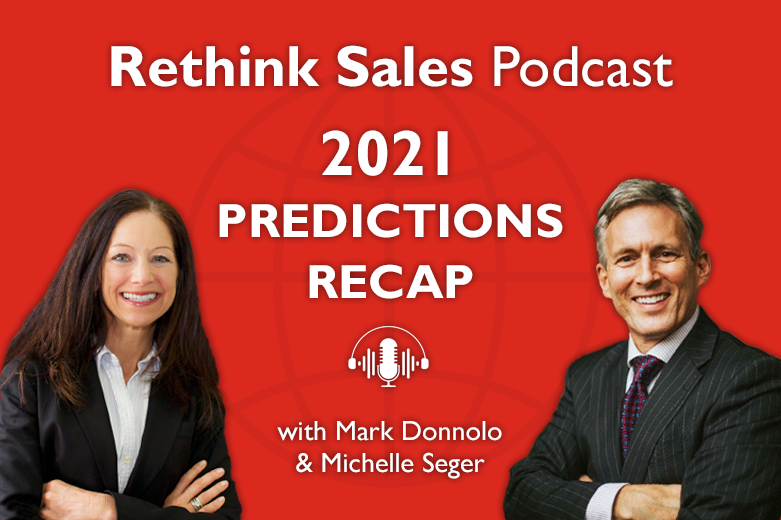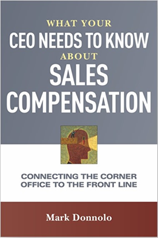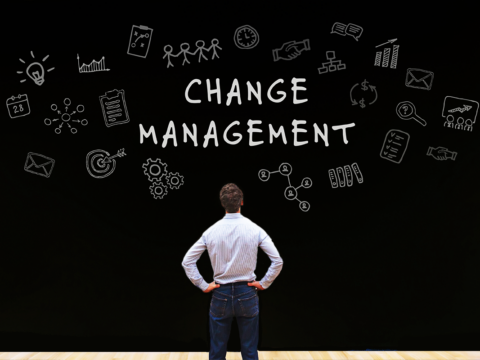Rethink Sales Podcast: 2021 Predictions Recap

Mark Donnolo
Welcome to the SalesGlobe Rethink Sales Podcast, I’m Mark Donnolo.
Michelle Seger
And I’m Michelle Seger.
Mark Donnolo
So Michelle, we get to look back on the year 2021 today, and the predictions we made at the beginning of the year for what would happen around sales effectiveness.
Michelle Seger
Yeah, what an interesting year it has been. And you know, Mark, I’m gonna go out on a limb, and I’m gonna predict something right now.
Mark Donnolo
What’s that?
Michelle Seger
We were more right than wrong.
Mark Donnolo
Did you look ahead? So we’re gonna see if we were right, or we are wrong, or maybe it’s still TBD. And it’ll carry into the next year. So, it’ll be fun to take a look at.
Michelle Seger
All right, so let’s look at our first prediction, which was that fear of financials we’re going to drive behaviors?
Mark Donnolo
Right? Yeah, I mean, when we started mind mapping this thing out, that’s what we looked at as the two drivers. So what did we say?
————
Mark Donnolo (flashback)
So we’ve been telling everybody fear and financials are going to be the big drivers of behavior for companies, sales and customers, I want to break that into a couple pieces. So the first one is really fear and liability. So you know, fear about is it going to continue? Is it going to come back? How long are we going to keep going on like this? We pulled a few stats here, and we’re making some some conclusions or some therefore about what you might want to do about it. So we’ve seen a couple different surveys recently, one of them right up here from Pew Research Center 39% of people say they definitely or probably won’t take the vaccine. And we’ve seen a few other sources that are very similar. So you got a lot of people that are still skeptical, even as the vaccine is coming out. And I think months ago, we were saying, well, when the vaccine comes out, everything’s gonna go back to normal, but we know there’s going to be considerable cycle time in that. And then we’ve got Dr. Fauci here saying, You got to have at least 75% of the population vaccinated to build herd immunity. So there’s kind of a big Delta there. Even if you get a lot more people that say they’re going to, they’re going to take it, it’s going to take some cycle time. So the big conclusion here is the vaccine is not the panacea for the sales environment, at least not in the near term. So caution is going to continue far into 2021. So it’s, you know, at the beginning of 20, mid 20, we’re gone. Okay, well, we’ll be getting back to normal during 2021, probably not. So it’s going to continue to limit the ability of us to connect salespeople to connect with teams, their teams, and with customers. And we’re probably going to be operating in this mode for some time. So this will be the new normal, we’ll get into the details of what this means in terms of sales organizations.
————
Michelle Seger
And expectations, it looks like are still going to be point of conflict, even as we look ahead. But this year, what we’ve seen is that expectation, that’s one of the things that we believe is driving that whole war for talent, as we see people that are leaving, they’re actually doing it, they’re leaving their job to go work for another company that may have a remote option for that.
Mark Donnolo
Right. So for your financials, and along the way, we’re talking about expectations. So I’d say we get it we get a green light on that one Michelle.
Michelle Seger
I would say let’s high five Mark on that one. Okay, so let’s take a look at another one.
————
Michelle Seger (flashback)
Yeah, so geographic boundaries will matter less. And I believe that people have heard us some have heard us say that right that predictions been around. But what do we know that 68% of sales leaders say that they’re adopting a hybrid selling model in 2021. Hybrid selling model, you’re going to hear this word. Now. As we’re researching, we’re finding that it’s becoming very commonplace to use that and it means that I’m, I’ve got a combo job right. Some of it is remote. Some of it is an office, some of it may be on site, we actually are hearing about some people that are starting to travel again, although not to the extent that they were and we’ll see that validated Mark as we look at what is happening with the airline industry and shortly, and then we’ve got 70% of buyers say that they prefer remote human contact over digital self-serve. So what does that mean? That means that good news, everyone we’ve been saying it all along, the sales role isn’t dead there is a place for human interaction. And it just may be that a lot more of it is not face to face, and where that’s going to play out. We’re not exactly sure yet how much will be in person how much will be remote, but what we do know is that your role of your salesperson will not be taken over by digital, it will not be taken over by bots, what we are finding is that those that are looking at shifting their selling models already are doing things like virtual selling so.
————
Mark Donnolo
And so, we get it right, or do we get it wrong Michelle?
Michelle Seger
I think we got this one right Mark.
Mark Donnolo
We said, you know, the sales role is not dead, it’s not going to be taken over by digital. But change is here to stay. And what we found was everything did not go digital, in fact, hiring picked up in the field and inside, and the new hybrid roles emerged, right? So, we had about 37% of companies increasing field hiring, about 44% of companies increasing inside and about 44% Increasing hybrid. And that’s going to be the big roll ahead. So feel the feel is alive and well. So, let’s look at the next one. And this one’s about collaboration and productivity.
———
Michelle Seger (flashback)
We know that 33% of employees who say employers are providing effective ways to collaborate just 33% That’s kind of a low number, don’t you think?
Mark Donnolo
Yeah. And I think you got to think about the employers too. They have to find new ways to help people collaborate. So you know, we’ve been deferring off on a video conferencing and things like that. And gosh, a couple months ago, Michelle, we asked the question about video conferencing, we said, okay, it’s great. This is accelerating technologies like this. But there has to be a paradigm shift where things really change in terms of how we collaborate. So, you know, again, we’re talking about this idea of how do we get beyond just the camera and the screen and the microphone? Is there some way that we can better connect?
————
Mark Donnolo
So where are we right or were we wrong, Michelle?
Michelle Seger
Unfortunately, we were very, very right. And I say unfortunately, because, Mark, this continues to be an issue. And, you know, at the time we made this prediction little did we know, we started having conversations with leaders, if you remember, and I remember one conversation, we had very specifically about a CHRO and this person’s direct team. And there was a disconnect, right? The CHRO was like, “We need to collaborate, we need to get in the office, we need to be face to face all of this remote, Zoom fatigue is making me crazy.” And his staff was, well, “I kind of like in this being home, really. You really think my productivity has decreased?” So that again, that’s that ties back to an earlier prediction around expectations. But the whole thing around the collaboration and the need for that and development, it definitely was seen as an issue and continues to be moving ahead.
Mark Donnolo
So, we sited something like 85% of the C-Levels thought that was going to be an issue and it has become an issue. And I think that perspective varies. So, like you said, Michelle, the leaders can see that there’s not the productivity, there’s not the collaboration, but then you get these people to go, “Oh, I’m fine working at home.” And I was like, well, no, you’re not because you’re not developing, right? You’re not connecting. But then we have the contrast now, right? Because when we have people in the office, we can now see the difference, right? All the neurons are firing, people are connecting. And what’s happening is we’re having this shift now of where it was all zoom or all teams, you know, all online. Now we have people in the office, and it’s like, oh wait, we got to make sure the people online can hear what we’re saying, right? So, it’s starting to shift back in a lot of ways. So that productivity, again, looking ahead, I think is gonna still be an issue if we continue to work remote for the long term, and I think we’re gonna see a backlash at some point.
Michelle Seger
Alright, so our next prediction is around quotas. So, what did we say?
————
Mark Donnolo (flashback)
So, let’s talk about those goals. Now. Those quotas, Michelle, because this has been a big question since the beginning of the year, which is what do we do with quotas?
Michelle Seger
Yeah, it has come up since March, actually, the end of March.
Mark Donnolo
And the answer was in the beginning nothing. And then the answer became okay, we’re going to go to more discreet quarterly quotas during 2020. So, we can get more visibility on what’s going on. And then, during all of this, companies were reforecasting so they’re trying to figure out what’s going on. And then some companies or a lot of companies have adjusted full year quotas as well.
————
Michelle Seger
Ouch, we were wrong.
Mark Donnolo
Part of it, yes.
Michelle Seger
At least on the first part. So, this whole thing about the short term quotas that we thought was gonna happen. Really what we saw in reality is that companies did not do that they stuck with that annual quota. But one thing that we did see, Mark, through a lot of our clients is that there was a challenge, supply chain issue and other macroeconomic factors. And so as a result, what we’ve seen is that quotas have been moved up to more like the team level, or regional or even market levels, which is definitely a change and as a result that has impacted some of the individual measures that are part of a plan design.
Mark Donnolo
Yeah. And in supply chain was not as apparent back when I made these predictions a year ago. But to your point about the supply chain issues, one of the big questions has come up is, well, if people do hit their quota, but we can deliver, then what do we do? Do we still credit them for attainment? And then the answer has largely been credit the rep because that’s what they control. So then the company kind of takes the brunt of that’s been the general answer.
Michelle Seger
It has been Yep. So let’s talk about where we were right.
Mark Donnolo
Yeah, I like that better. I like talking about we’re right.
Michelle Seger
I like that too. So, we said that history is history.
Mark Donnolo
That’s right, history, history, history, which is true, right. So as companies looked ahead, they could not look back and actually use historical methods to set the goals, what they do is start to look ahead, look at better demographic firmographic information. And that, in our experience has largely been the case. So companies are becoming more focused on that.
Michelle Seger
And something that I have found really interesting. But you know, pre pandemic, we know the importance of and we really well, gosh, we wrote a book about it, strategic account planning and how important that is right. And yet, it really wasn’t considered a top priority of a lot of organizations that had become that static report that just sat on someone’s laptop, never to be looked at again. But what we are seeing is that it is becoming a living, breathing process and a part of the really key process to set quotas appropriately and hit the goal.
Mark Donnolo
Yeah, in with emphasis on that second point, hit the goal. How do you hit the goal? So we have seen a big uptick in terms of effective strategic account planning, what I call aspirational account planning. So not just like you said, filling out the boxes. But how do we look three years out, five years out and put out some audacious goals? And how do we change the way the customer sees us now to build stronger partnerships? There’s been a big shift in that. And I think that’s, that’s helped a lot of organizations that have focused on it.
Michelle Seger
We are definitely seeing it make a difference.
Mark Donnolo
Okay, so let’s look at some predictions, Michelle, around compensation. Everybody’s favorite topic!
Michelle Seger
Oh, yeah.
Mark Donnolo
So, the first one is around payment of salary and incentive mix. So, what did we say?
————
Mark Donnolo (flashback)
All right, and then pay mix – getting into compensation a little bit here. So, pay mix. 60% of organizations have plans with at least 200% upside potential for the 90th percentile performers. So, we’re seeing a move toward more upside potential in plans. And what we believe we’re going to see in 2021 is a shift to PE mix becoming more aggressive to emphasize performance and lower fixed investment. So, with the uncertainty, we think we’re gonna probably see a shift toward moving some of that to the sales organization in return for additional increased upside opportunity.
————
Michelle Seger
And we were right.
Mark Donnolo
That’s right. We like that when we’re right!
Michelle Seger
Yes, we do. So, Mark, let’s talk a little bit about what’s going on with pay levels overall. So, one of the things that we know is that for white collar jobs, that salaries are error that pay is increasing 20 to 30%, across the board. And what we’re finding is that base salaries are going up, as well as incentive. But at the same time, we’re also finding that the pay mix itself, it’s becoming more aggressive. And what that means is that there’s even more pay at risk. So, let’s get into that survey that we did earlier this year that went into incentive and how that’s shifting across jobs.
Mark Donnolo
Right, so we mentioned before that the hiring is up and field sales, inside sales, and hybrid.
Michelle Seger
Yeah.
Mark Donnolo
Where we’re seeing the biggest incentive increases in terms of the aggressiveness. The incentive is in the hybrid jobs. So those have a lot more pay at risk than then field and inside right now. So that’s the big spot and that’s the job, that’s actually, you’re growing the fastest.
Michelle Seger
And let’s tell people I mean, we conjecture that the reason that they’re able to increase the aggressiveness of that pay for that particular role so much is because it’s a new role, right? So, you’re not like going in and doing dramatic changes to existing roles. But as companies are adding hybrid roles, we believe that that’s why those jobs have an opportunity to be much more aggressive on the incentive side of the equation.
Mark Donnolo
Right. And then on the upside, we did say that upside opportunity is going to go up. And on that one, I think we’re wrong, because we have not seen substantial increases in upside, the same ratios of upside to incentive pay have pretty much held. So, it’s not like companies just increase the upside. But certainly, the plans have gotten a lot more lucrative.
Michelle Seger
That’s right. Alright, so following up on incentive, let’s talk a little bit about the compensation plans themselves, let’s hear what we had to say.
————
Michelle Seger
(flasback)
So, we know that they’ll become simpler 25%. And in that survey that we did again, with World at Work, they said they use only one performance measure. Now, in 2016, they did a similar survey, and it’s up 71% from the number that it is now. So, companies are getting more simplified. And we are being asked to simplify and you know, part of that is now people are working remote, you need a simpler way to measure their results, they need an easier way to understand. And it’s not going to happen as easy when you’re communicating through zoom, or across some of the platforms, even Salesforce, so we are being asked to look at simplicity and companies are even focusing on the technology that will help them manage those plans, as well.
Mark Donnolo
And so that’s providing more latitude as well as 2021 comes up, where instead of saying, well, we need you to sell these certain product groups or sell to certain types of customers, or whatever the stipulations might be in a plan typically, gives more flexibility as 2020 happens and strategy shift. What it also does is it does transfer more of that responsibility on to the sales manager. So, we as managers are gonna have to do a better job of of leading and directing the frontline instead of allowing the plan to do all of that. So it’s almost like taking some of the governors or regulators off the plan and shifting that to management.
————
Mark Donnolo
So, Michelle, on this one, we’re not quite right.
Michelle Seger
No, we weren’t Mark.
Mark Donnolo
There’s been a lot of demand to simplify plans. But what we see when we look at companies overall, is where plans went to single measures. During 2020, you had about a quarter of companies just have one measure in their plans. that’s actually dropped later in the year to about 11% of companies. And you have almost 60% of companies that are using three or more measures in their plan. And there’s a consistent theme here, which I think is is kind of revealing, which is we got through the pandemic or at least through the belly of the pandemic, but the controls are back. So, we’re more specific, or companies are more specific about what they’re measuring. And then when we had the thresholds that got taken off the plans during the pandemic, those are back so you have to hit minimum performance requirements. And then the pay caps and blue bird policies are back as well. So, I think there’s an interesting dynamic here, in that the controls are back yet we have a war for talent and you would think controls would be loosened up to be more attractive. So, we have to see how that plays out.
Michelle Seger
Yes, we do. It’s very unusual what we’re seeing right now, because those caps in plans, those bluebird policies are always a good thing. But the caps in the plans and the thresholds we’re seeing in the number of the controls, it’s been very surprising for us. And speaking of the belly of the pandemic is about time for lunch.
Mark Donnolo
It’s always lunch somewhere, Michelle. So along with compensation, Michelle, comes the question of turnover because that’s an important thing to people. And we made a prediction that turnover was going to increase everybody’s hunkered down during the pandemic turnover is going to increase. And we were right about that as well. And it has and let’s talk about that.
Michelle Seger
Right, because turnover hasn’t just increased because people are leaving their companies if they if they have to go into an office. We know that that’s absolutely not true. But what we are finding is that as people have been working remotely, they’ve been really thinking about their careers. They’ve been thinking about the amount of time that they spend at work and how they’re spending their time overall, you know, in their lives. And what we’re finding is that, you know, companies that are very clear on their vision, on their mission, and even looking at how their beliefs, what their beliefs are, and being clear about that, that’s drawing people that have those same beliefs and that believe in that mission and vision as well.
Mark Donnolo
Right, so you’ve got a shift in supply and demand with the labor market and, and employment. And then people have choices the market is getting, you know, back to the compensation point the market is getting bit up. Right. So, it’s frothy now in terms of compensation. So, you have people out there taking higher pay levels, you have some people, I think just fishing, looking for more than they’re actually worth. But there’s there is that there’s that movement. So, as you said, bigger purpose, better pay, and it’s going to directions, really, in terms of what people want on the remote work. Some people are like, “I’ve got bunny slippers, fatigue, I can’t sit around my house anymore and do zoom calls all day, I need to get out”, right? Other people go, “Well, my employer wants me to come back to work, and I don’t want to come back to work anymore. So therefore, I need to find a place where I can stay at home and bunny slippers.” Right. So, you got both directions going. But there’s definitely movement. So that was that was a big prediction force, which I think is totally true at this point.
Michelle Seger
Okay, so next we’re going to get into data. And actually, how data can be leveraged to support sales, process messaging, and what’s communicated to customers. And with that, we’re also gonna get a little bit into the salesperson of the future.
————
Mark Donnolo (flashback)
So, we think that organizations are going to have better data support capability. And what that means is that we’ve talked about the idea that you can’t just rely on the relationship anymore with customers to make the sale, we think one of the big differentiators is going to be better problem solving, like we said before, but that’s got to be data driven, analytical problem solving. So salespeople are going to have to arrive at the sales call, whether it’s virtual or in person with better information, and better recommendations and better ability to have problem solving conversations. How do you do that? Well, you have better data about the customer about their industry about their situation. How do you do that? Well, salespeople don’t have time. Right? So, we think we’re what we’re going to see in sales organizations is probably more data support capability in terms of teams or organizations to develop that information for the sales organization. And the salesperson of the future is going to be the data driven creative problem solver. So, they’re going to have to, we’re gonna have to change the playbook. And we’re going to have to equip sellers to be able to do that better.
————
Michelle Seger
Right, again, Mark?
Mark Donnolo
That’s right, Michelle. So, what we’re seeing is an increase in building out data support capability for solution development and problem solving. And then we’re also seeing something similar to that as well, which is an increase in omni channel. So, the connection point between all these different channels, so buying online, talking to a person, in person, etc. So essentially, the B2C, the business to consumer experiences moving to B2B. So more of our clients are asking us, how do we create a seamless experience so they can buy however they want to buy, if they don’t want to see somebody? You know, because back to the data point, they can the customer can do all of their research, they can get all their information, their data online, because we can fulfill that part of the sales process without having to have somebody in front of them.
Michelle Seger
Yes, and we believe that that’s why the role of the sales rep is changing over time because what they were doing in the past is not necessarily what the expectation is any longer, the buyer. And if they continue to sell and serve as the way that they happen, they’re going to become irrelevant.
Mark Donnolo
Right. So, it’s no longer just about relationship, or just about providing information or just about fulfillment. It’s about problem solving. What we think of is that data driven creative problem solving, which interestingly ties back to the whole point on aspirational account planning. That’s what that’s all about is how do we differentiate for our best and biggest or highest potential customers, it’s through that type of problem solving. So that kind of connects back very nicely.
Michelle Seger
That’s right. So, relationships remain important, however, how they’re structured and what’s communicated in the expectation of the communications back and forth is what’s changing.
Mark Donnolo
So, that was a lot of fun, Michelle – 25 predictions. You can check on all 25 on our website. Like I said, we don’t want to take you through all of them today, but then we’re going to our predictions for 2022. So, listen for that and Michelle, let’s charge ahead into the new year with everybody and have a successful 2022.
Michelle Seger
Sounds great, Mark!
![]()

What Your CEO Needs to Know About Sales Compensation is the first book to address sales compensation challenges from a C-suite perspective. It’s an executive-level guide to understanding the power and effect sales compensation can have on the business through the wisdom of CEOs and effective practices across industries. This book tells the story of how the C- level has made the connection between corner office priorities and front-line sales.

We Rethink Sales…
SalesGlobe is a data-driven, creative problem-solving firm for sales that solves the most challenging problems.



